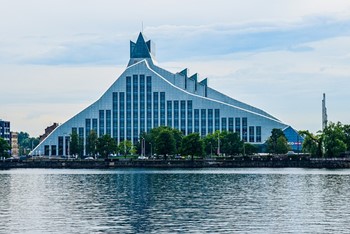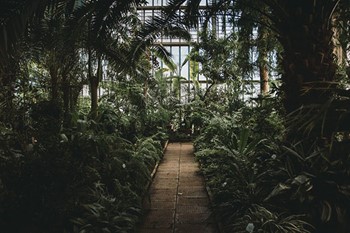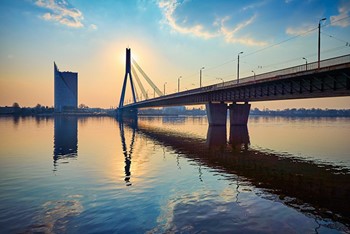Sights to see in historical Riga
The Āgenskalns neighbourhood on the west bank of the Daugava is often overlooked when people visit Riga, however this side of the river has its own spirit, history and traditions to discover. This side of the river, known locally as Pārdaugava which literally translates to Over Daugava, can easily be reached with our Historical Riga sightseeing bus tour. And there are plenty of sights here to lure you away from the east bank with its Old Town and Art Nouveau district.
National Library of Latvia
Since 2014, the National Library of Latvia has found a home in a new building designed by Gunnar Birkerts. As well as being home to the collection of national literature, the library also hosts a variety of exhibitions and events. The building is often referred to as the Castle of Light, which comes from Latvian folklore which was the inspiration for the building’s design.
In Latvian folklore, a crystal mountain symbolizes the height of achievement – something not easily attainable but full of rewards for those who make the commitment to reach its peak. Latvian literature and folklore also refer to the 'castle of light' as a metaphor for wisdom that has been lost, but will rise again from the depths of the Daugava River after the Latvian people have overcome the intellectual darkness of war, invasion and occupation.
Victory Park & Monument
This, almost 37 hectares, park is home to one of Riga’s most controversial sights, the Soviet Victory Monument. The park was first created in 1909 when Latvia was part of the Russian Empire, later in 1923 the park was renamed to honour Latvia’s victory during the Latvian War of Independence. The park has lush open fields, great routes for running or roller-skating and in winter there is a cross country ski track with artificial snow.
The monument was built in 1985 and officially has the name ‘Monument to the Liberators of Soviet Lavtia and Riga from the German Fascist Invaders’. As that is a bit of a mouth full it is more often referred to as the Victory Monument. The monument consists of a 79 metre tall obelisk and two groups of bronze statues, representing Mother Russia and soldiers advancing with their weapons raised. Over the years there have been several attempts to have the monument removed, yet it is used every year as the location of the Victory Day ceremony on 9 May.
Botanical gardens
Ever since 1926, when Latvia’s oldest botanical garden moved to its current location, the gardens have flourished with thousands of common and rare flowers, plants and trees. The Botanical Garden, which is part of the University of Latvia, also features a pond, a huge palm house and a tropical butterfly house.
Only a 15-minute walk from stop 17 of our Riga Sightseeing tour, you can enjoy guided tours through the Botanical Garden or wander among the 6000 different types of flora on your own. Whether you are a gardening enthusiast, a botanical expert, or just want to spend some time in a beautiful and pleasant environment, you will always find something interesting here. And you can buy seedlings and indoor plants to take home with you.
Alīses / Āgenskalns water tower
Though there is a dedicated Art Nouveau district on the opposite side of the river, Āgenskalns is a vivid example of architectural symbioses between the Art Nouveau and German Balts style. One of the best examples of this is the water tower, located at Alīses 4, which was built in 1910.
The entrance of the water tower is decorated with a stylised version of Riga’s coat of arms as well various geometric ornaments and other Art Nouveau features. The impressive structure is 40 metres high, has 2 metre thick walls and was once used as an underground recording studio called Tornis.
Holy Trinity Church
This site has been occupied by a church since 1453, while the current 17th century Russian baroque-style building was completed in 1893. The Holy Trinity Church is impossible to miss because of its colourful appearance and height.
The building’s walls are red with white details while the domes are bright blue and the belfry is green. You can take in the elaborate interior outside of service hours. You’ll find yourself surrounded by hundreds of icons as is common in Orthodox churches as well as the distinct smell of incense.
Vanšu Bridge and Ķīpsala beach
There are five bridges in Riga that cross the Daugava, the Vanšu Bridge is the most northern of the five. It is a 595 metre long cable-stayed bridge and was built when the Soviet Union occupied Latvia in 1981. The west bank of the river offers a viewpoint of not only the bridge but also of Old Town on the opposite side of the river.
When you cross the bridge the viewpoint is on the left side. On the right you’ll find a proper beach, at least you will in summer. The beach has changing cabins, portable toilets and even a beach volleyball court. It is one of the view places in the city proper where you can cool off on hot summer days.
Žanis Lipke Memorial Museum
Further north on the island of Ķīpsala, you can visit a modern, interactive museum that is dedicated to Žanis Lipke and a network of about 25 people who saved Jews from the Nazis during the occupation of Latvia. Žanis Lipke hid people in a bunker on his own land, which is now home to this museum.
Together with others he helped Jews escape local ghettos and transported them to safe houses around the country. A free audio guide will help you to navigate the half light of the museum, which is left intentionally dark to mimic the conditions endured by families hiding in bunkers and warehouses at the time.
